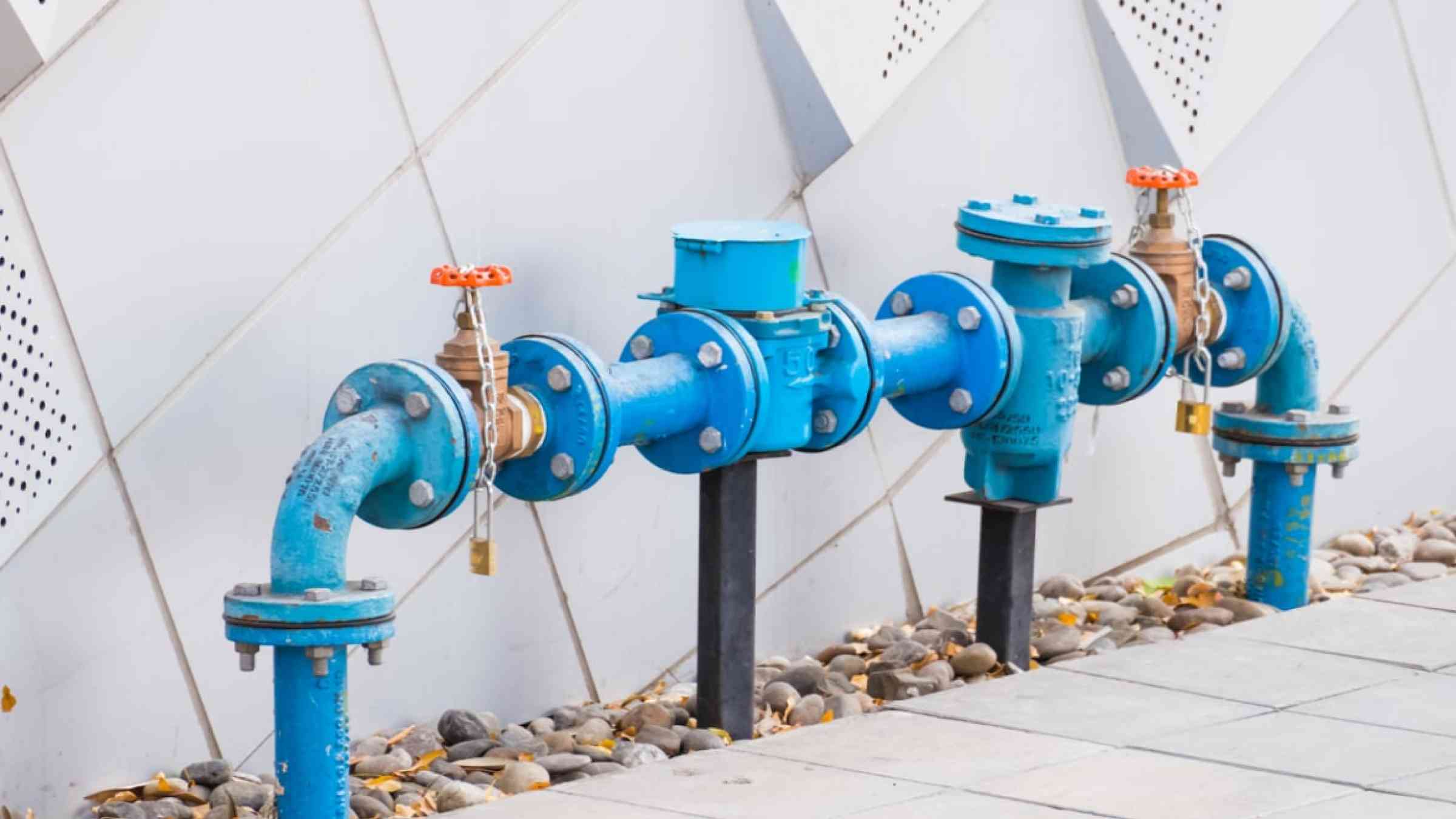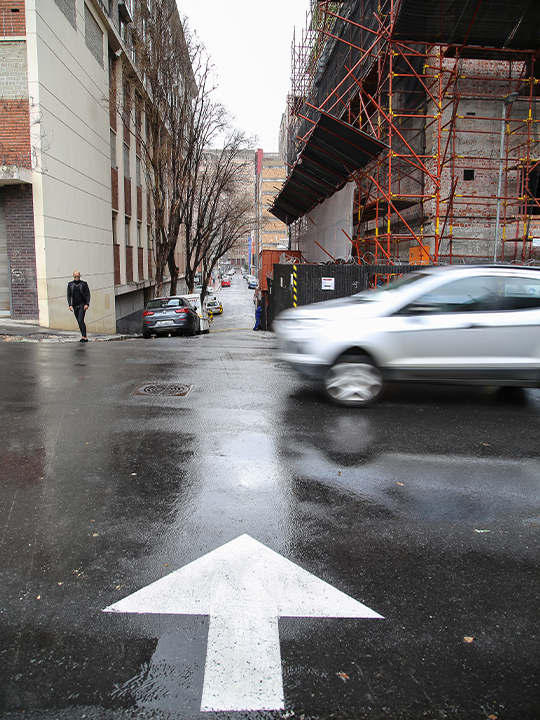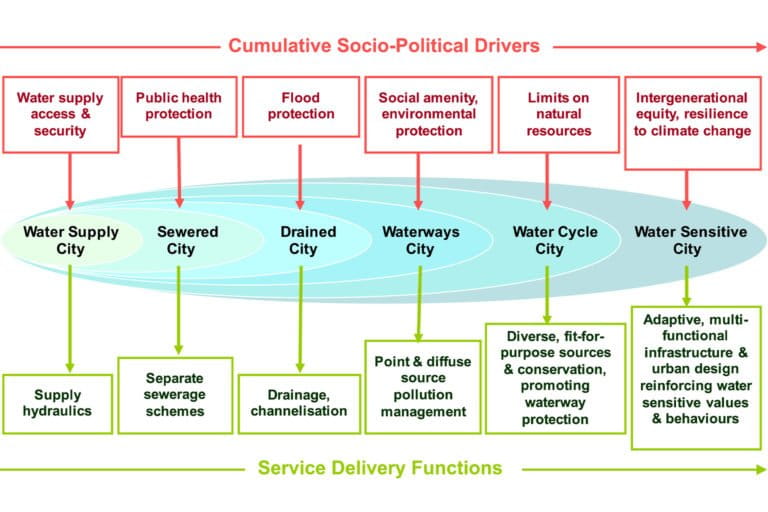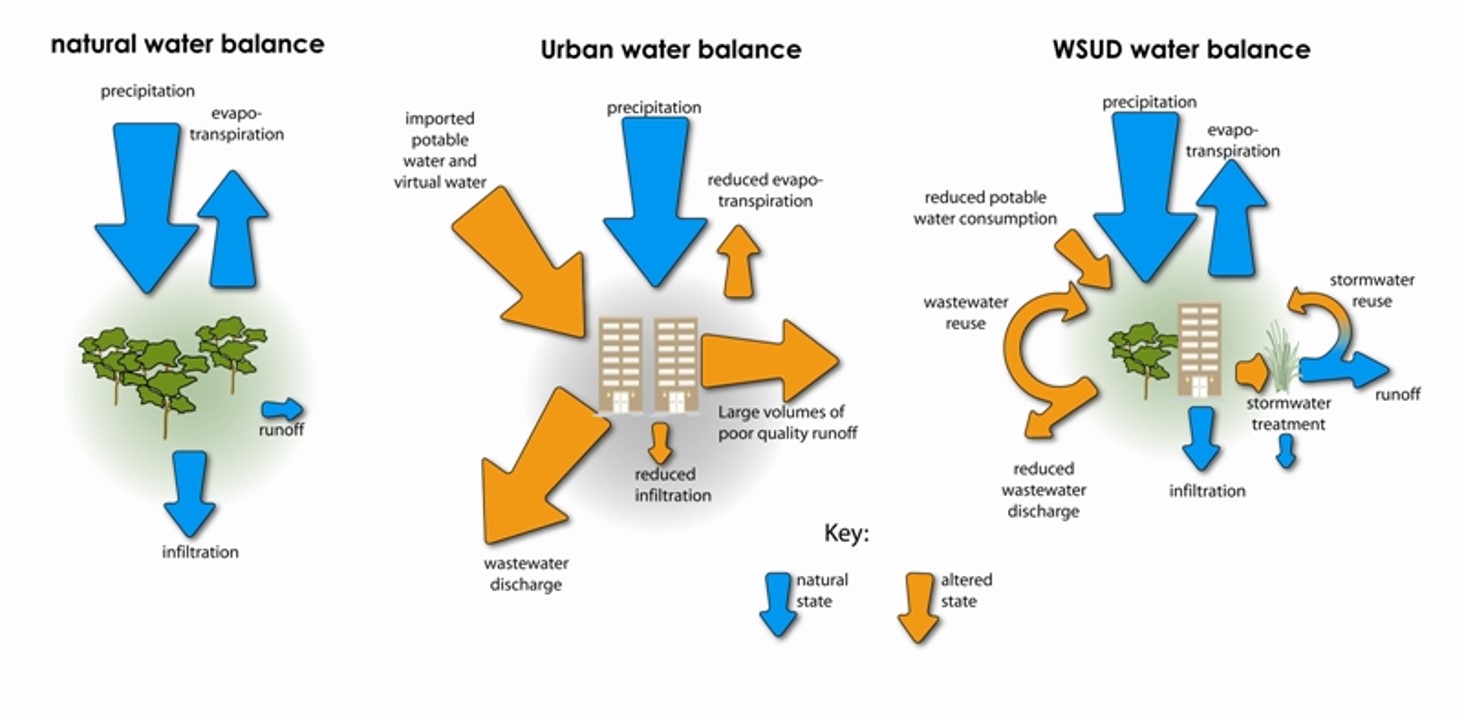As populations grow, how will thirsty cities survive their drier futures?

- The world’s rapidly expanding cities are on a collision course with climate change, presenting unprecedented challenges to municipal and national governments as they work to continue providing residents with access to safe and sufficient water.
- Increasingly, calls are made to rethink the way we develop urban watersheds and the way we live in them — with water sourcing, transport, use and reuse planning key to the process. One approach, water-sensitive urban design (WSUD) entails a complete reimagining of the role and use of water in urban areas.
- WSUD embraces the water cycle, and considers the entire watershed where cities are located. It uses green infrastructure such as permeable pavements, green roofs and rain gardens, to greatly reduce stormwater runoff. Conscious design allows water to be recycled and reused repeatedly for various purposes. Waste is greatly reduced.
- Some cities are already changing their development pathways to be more resilient to inevitable future climate extremes, with Singapore and Cape Town leading the way. Future water stress can be overcome, but work needs to start now before extreme weather events, including mega droughts and floods, hit.
“Apocalyptic.” That’s how it felt, says Charlene Pepler of life in Cape Town, South Africa, as the metropolis edged toward Day Zero in 2018. Following a record-breaking drought, this city of more than 4 million people was about to turn off the taps: Day Zero referred to the point at which dams supplying the city’s water fell below 13.5% of capacity, forcing the shutoff of municipal supplies.
“There were these photos of how we’d have to queue for water at places guarded by the military with guns. It was very scary,” recalls Pepler, a Cape Town citizen and tour guide who depends on showcasing the appeal of her city to international tourists for a living.
Saved by the rain, and substantial voluntary reductions in daily water use by Capetonians, Day Zero was narrowly averted, but it serves as a grim reminder of the unprecedented challenges faced by the world’s expanding cities as they try to guarantee safe and sufficient water for residents in a time of escalating climate chaos and increased precipitation uncertainty.

The mega challenges of a water insecure future
Though more than half the world’s nearly 8 billion people now reside in urban areas, a projected 68% will do so by 2050 — meaning that lessons learned in Cape Town and elsewhere need to be rapidly applied to avoid disaster.
Over the past 20 years, progress has been made to improve living standards and help billions gain access to safely managed drinking water services. But over that same period, the number of city inhabitants lacking safely managed drinking water has still grown by more than 50%. Worse news: electricity generation and domestic use will be major drivers of a global increase in water demand of 55% by 2050, according to the 2021 Progress Report on SDG 6, the Sustainable Development Goal to ensure access to clean water and sanitation for all by 2030.
Over the coming decades, climate change will bring unexpected changes in the temporal and spatial distribution of water resources. As greenhouse gas emissions increase, the frequency and intensity of water-related disasters, including droughts and floods, are projected to rise significantly, with impacts felt in developing and developed nations.

In fact, those effects are already hitting home. Brazil is currently facing its worst drought in 91 years, with rain likely to remain scarce in some states until September, potentially impacting a third of the country’s population. Large tracts of the western United States are also currently experiencing severe and exceptional drought — referred to by some as a mega drought (a period of extreme dryness lasting for decades), a water crisis pushed into extreme territory by climate change.
Additionally, industrialized agricultural practices and their expansion, along with destructive land-use change, ranging from deforestation to pollution, will widely disrupt ecosystems, further contributing to a decline in water quality and availability in cities.

The search for urban water solutions
In the past, governments trying to meet soaring urban water demand would typically look to the expansion of existing water infrastructure. But in many urbanized areas today, available surface water and groundwater sources have already been fully allocated, or even depleted.
Instead of looking farther afield, or digging deeper, progressively stronger calls are being made to find sustainable answers within urban areas and their catchments, and via urban water management strategies.
“We certainly believe that’s where solutions lie,” says Kirsty Carden, acting director of the Future Water Institute (FWI) at the University of Cape Town. This transdisciplinary research institute addresses issues of water scarcity across South Africa and is one of a handful of organizations globally that focus on water-sensitive urban design (WSUD). This approach entails a complete reimagining of the role and use of water in urban areas, and is already being applied to varying extents in cities worldwide with promising results.

Water-sensitive urban design
A city’s structure and population pose a severe disruption to the planetary and regional water cycle, with water management on a megalopolis scale traditionally achieved via an engineering feat by which a vast amount of water is extracted from surface and groundwater sources, treated and piped over large distances for use, only to be treated again, and discharged.
Concurrently, as urban impermeable surfaces — including roads, parking lots and buildings — increase, water that can no longer infiltrate underground becomes a flood risk. As a result, stormwater systems swiftly transport rainwater out of a traditional city, often via combined sewer and stormwater outflows (CSOs) with pollutants picked up along the way. When built, these gigantic but antiquated systems rarely considered environmental sustainability or the impacts within the city’s watershed, both upstream where water is stored and extracted, and downstream where it is discharged.
By contrast, WSUD embraces the water cycle, integrating cities into it. The concept, developed in Australia in the early ’90s, originally focused on sustainable stormwater drainage systems. As an alternative to traditional stormwater systems, WSUD relies heavily on nature-based management solutions. Green roofs, rain gardens, permeable pavements and vegetation strips are examples of “green” infrastructure applied close to where stormwater is generated. On a larger scale, artificial wetlands and detention ponds (large depressions that store stormwater runoff) can serve to decrease the volume and speed of runoff and guide water to seep underground to recharge the water table.
WSUD’s benefits ripple far beyond stormwater and flood management. Less pollutants are transported via the stormwater system, improving water recreation areas, while plants cool cities down, improve air quality, increase biodiversity and create pleasant urban living spaces.
And it saves money: the city of Toronto, Canada’s most populous metropolitan area, adopted a “green roof” bylaw in 2009 that required the construction of green roofs on new developments. Program achievements published in 2018 included the diversion of 11 million liters (2.9 million gallons) of stormwater from sewers annually, saving the city about $100,000 in stormwater management. Due largely to a reduced need for air-conditioning, roughly 1,000 megawatt-hours per year in energy savings is also achieved, with roughly 220 metric tons of greenhouse gas emissions avoided.
WSUD has over time developed into a sweeping vision that focuses attention broadly over the entire urban water cycle to create a city that is resilient to the impact of shock events like droughts and floods, while delivering sustainable benefits to all residents and the environment.
Conscious design allows water to be recycled and reused repeatedly for various purposes depending on its quality. Under WSUD, waste and grey water, stormwater and treated sewage effluent are not negatives to be gotten rid of, but are positive potential water resources to draw supply from, as are groundwater and desalinated seawater, over and above the traditional options of surface and groundwater.
A key aspect of WSUD is water conservation all along the supply path; water resources must be protected, and water must be used as efficiently as possible by all users.
WSUD also seeks to not only create water security in the urban area where it is being practiced, but is cognizant of the impact of achieving water security throughout the entire watershed in which that city is located. Such an approach must factor in other uses that compete with urban requirements, such as agriculture and industry. By considering and integrating all these aspects, the threat of shortages due to system stress is reduced.
Our water future: Singapore puts WSUD into practice
Commonly, the evolution of water-resilient urban areas proceeds through different states, starting historically with the traditional development of clean and sufficient water supply systems, sewage and drainage systems. The next stages include considerations for environmental health and threats to water supply security.
Further along the continuum, city utilities start to tap into nontraditional water sources such as wastewater and stormwater. Finally, in a so-called water-sensitive city, water is embedded as a critical element of urban planning. Infrastructure becomes adaptive and multifunctional. Communities partner with utilities to deliver water services, while governance supports accountability and collaboration.
Still, WSUD is not a one-size-fits-all solution. “Everybody’s situation is different depending on climate, water, development status and so forth,” FWI’s Carden says. But importantly, there are functioning WSUD examples out there demonstrating that things can be done differently and well, and pointing the way toward a hopeful future. Singapore is perhaps the best-known case.
Identified by the World Resources Institute in 2015 as one of 33 out of 167 countries most likely to face extreme water stress, Singapore’s future water security is built on a suite of solutions in line with water-resilient rationales.).
Already, the sovereign island city state is maximizing water yield, and is one of the few nations on Earth to substantially harvest urban stormwater for potable consumption. Though water is still imported from neighboring Malaysia, Singapore’s future water security will depend on highly purified reclaimed water known as NEWater, produced from treated used water, including sewage, and further purified with advanced membrane technologies and ultraviolet disinfection. Singapore will also increasingly depend on desalination, with a number of plants already opened since 2005. In this far-seeing, all-encompassing hydro system, waterways and reservoirs double up as public recreation facilities, while residents are expected to play a critical role, conscientiously reducing daily per capita water use.
But Singapore is a wealthy nation, and attaining water resilience there and elsewhere in the developed world is relatively easy when compared to challenges encountered in developing countries, Carden says.
According to U.N. statistics, developing countries account for 93% of urbanization globally, 40% of which occurs in often haphazard slum expansion — 30% of today’s city dwellers reside in extremely poor neighborhoods. In a country like South Africa, for example, many residents do not even have access to basic services. That is why in South Africa reference to the word “urban” in WSUD has been removed, with water-sensitive design (WSD) the preferred term, in recognition of informal settlements included in development plans. “The need here is for a balance between providing all residents a similar level of service to maintain their livelihoods,” Carden says.


Our water future: South Africa’s WSD water-resilient settlements
In South Africa, the WSD concept is relatively new, with the country’s first framework, co-authored by Carden, published in 2014. However, due to rapidly mounting pressure on the country’s freshwater resources, Carden says there is already a significant push in the nation’s big metro areas to set up WSD strategies. In the wake of the worst drought that the Cape Town region has confronted in recorded history, the infamous Day Zero water emergency, the city has emerged at the forefront of ambitious WSD planning.
Cape Town aims to be water resilient by 2030, and a water-sensitive city by 2040. Resilience is defined as the ability to withstand and thrive in the context of an extreme shock event, says Gareth Morgan, Cape Town’s director of resilience. In this scenario, Cape Town should be able to withstand a significant drought event, with water restrictions only marginally impacting the continuity of businesses and households, compared to the Day Zero drought that had a discernable impact, Morgan says.
In the 2040 scenario of a water-sensitive city, Morgan says there will be far more integrity embedded into the city’s water cycle. This means water will be reused to a much greater degree, and the quality of water discharged into downstream waterways will be good enough for people and the environment when used for recreation or by ecosystems.


In Cape Town’s Water Strategy, the roadmap leading to a sustainable future where there will be sufficient water for all, despite climate and other shocks, the first priority remains safe access to water and sanitation for all residents, with well-defined minimum standards. Second, the city has committed to promote the wise use of water; that includes water conservation and minimizing losses in the water transport system, a critical concern.
Globally, water loss, or non-revenue water (NRW), is a serious challenge. Research shows that an estimated 346 million cubic meters (91.4 billion gallons) of water is lost by water utilities around the world every day, either through leakage in vast water transport systems or illegal connections, worth about $39 billion per year. A reduction of just one-third of these losses would save enough water to supply 800 million people with a sufficient amount of 150 liters (40 gallons) of water each per day.
Cape Town has already substantially improved on its water losses. Currently, an average of 37% of all water supplied to South African municipalities is lost, but Cape Town’s loss figure comes in at around 16%, less than half the national rate, and the lowest of any South African metro area.
Ensuring that the water cities already have is used as efficiently as possible, before sourcing new water supplies, is fundamental to any urban water solution, says Robert McDonald, lead scientist for nature-based solutions at The Nature Conservancy (TNC), an NGO. McDonald researches the impact and dependencies of cities on the natural world.
He notes that invasive vegetation, for example, has become a chronic problem in the world’s urban areas, with invasive plants continuously being cleared from Cape Town’s water catchment. Research shows that investment in clearing these system-clogging exotic plant species and restoring the city’s primary catchments will yield water at a cheaper rate than building new dams, installing desalination plants or drilling boreholes — demonstrating that cooperating with nature is not only smart, but economically beneficial.

Sourcing new supplies in Cape Town
When water supplies do have to be increased in future as part of the long-term city planning process, the natural limits of an urban watershed’s water supply should be respected, McDonald says.
For Cape Town, future water resources being explored include underutilized aquifers, water reuse, and desalination. Over and above reliance on diversified water resources, the water transition of Cape Town includes making optimal use of stormwater and urban waterways for the purposes of flood control, aquifer recharge, water reuse and recreation, based on sound ecological principles.
The future of Cape Town’s water security is dependent on everyone in the sector, ranging from local and national government, to users at the household and business level, Morgan explains. It will require close collaboration between stakeholders and partners in the catchment, including other urban and agriculture water users and spheres of government.
Despite the work done so far, FWI’s Carden says she doesn’t expect to see a transformative moment when the municipality can suddenly proclaim itself a water-sensitive city. Instead, the transition will be incremental, and happen as a combination of city- and resident-led initiatives integrate a groundswell of support in communities, involving everyone in activities such as river cleanups and water conservation efforts.
“Cities have overcome huge water challenges” in the past, TNC’S McDonald says. “When there’s an economic need for cities to grow, cities tend to find water.” However, he adds there are big costs associated with that growth, and the political will to succeed is integral.
Over the long term, water stress can be overcome, he argues, but options will become much more limited and expensive the longer stakeholders wait, and the intensity and occurrence of climate change-induced extreme droughts increase. McDonald hopes cities start planning for their water security and for extreme climate events now, rather than waiting for the crisis to deepen.
Cape Town is a case in point. The water conservation strategies it began implementing before the infamous drought contributed greatly to averting disaster. Since 2018, the city has taken large steps to become more resilient to crises. And, Morgan says, the lessons learned are as applicable to drought as to floods and fire. “I would encourage many other cities to look at water through a multitude of angles and not merely as an engineered service,” he says.
For many Capetonians, the direct experience of their city’s nearly disastrous collision with Day Zero forever changed their perspectives regarding water. “All the things that we now do in Cape Town, like growing water-wise gardens and not flushing our toilets after every pee can be incorporated in other big cities,” Pepler concludes. “I absolutely used to take water for granted, but I will never do it again.”